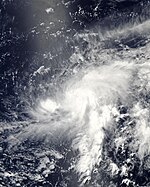User:Jarda2020/2022 Pacific typhoon season
| 2022 Pacific typhoon season | |
|---|---|
 Season summary map | |
| Seasonal boundaries | |
| First system formed | March 31, 2022 |
| Last system dissipated | Season ongoing |
| Strongest storm | |
| Name | 01W |
| • Maximum winds | 55 km/h (35 mph) (10-minute sustained) |
| • Lowest pressure | 1002 hPa (mbar) |
| Seasonal statistics | |
| Total depressions | 1 |
| Total storms | 0 |
| Typhoons | 0 |
| Super typhoons | 0 (unofficial) |
| Total fatalities | 49 |
| Total damage | Unknown |
| Related articles | |
The 2022 Pacific typhoon season is an ongoing event in the annual cycle of tropical cyclone formation, in which tropical cyclones form in the western Pacific Ocean. The season runs throughout 2022, though most tropical cyclones typically develop between May and October.
The scope of this article is limited to the Pacific Ocean to the north of the equator between 100°E and 180th meridian. Within the northwestern Pacific Ocean, there are two separate agencies that assign names to tropical cyclones which can often result in a cyclone having two names. The Japan Meteorological Agency (JMA) will name a tropical cyclone should it be judged to have 10-minute sustained wind speeds of at least 65 km/h (40 mph) anywhere in the basin, whilst the Philippine Atmospheric, Geophysical and Astronomical Services Administration (PAGASA) assigns names to tropical cyclones which move into or form as a tropical depression in their area of responsibility located between 135°E and 115°E and between 5°N–25°N regardless of whether or not a tropical cyclone has already been given a name by the JMA. Tropical depressions that are monitored by the United States' Joint Typhoon Warning Center (JTWC) are given a number with a "W" suffix.
Seasonal forecasts[edit]
During the year several national meteorological services and scientific agencies forecast how many tropical cyclones, tropical storms, and typhoons will form during a season and/or how many tropical cyclones will affect a particular country. These agencies included the Tropical Storm Risk (TSR) Consortium of University College London, PAGASA and Taiwan's Central Weather Bureau.
Seasonal summary[edit]

Systems[edit]
Tropical Depression 01W[edit]
| Tropical depression (JMA) | |
| Tropical depression (SSHWS) | |
| Duration | March 31 – Present |
|---|---|
| Peak intensity | 55 km/h (35 mph) (10-min); 1002 hPa (mbar) |
The JMA upgraded a low-pressure area to a tropical depression over the southern portion of the South China Sea, on March 31. The JTWC issued a TCFA during the next day as it gathered strength. Initially forecast to intensify to a tropical storm.
Storm names[edit]
Within the Northwest Pacific Ocean, both the Japan Meteorological Agency (JMA) and the Philippine Atmospheric, Geophysical and Astronomical Services Administration (PAGASA) assign names to tropical cyclones that develop in the Western Pacific, which can result in a tropical cyclone having two names. The Japan Meteorological Agency's RSMC Tokyo — Typhoon Center assigns international names to tropical cyclones on behalf of the World Meteorological Organization's Typhoon Committee, should they be judged to have 10-minute sustained windspeeds of 65 km/h (40 mph). PAGASA names to tropical cyclones which move into or form as a tropical depression in their area of responsibility located between 135°E and 115°E and between 5°N and 25°N even if the cyclone has had an international name assigned to it. The names of significant tropical cyclones are retired, by both PAGASA and the Typhoon Committee. Should the list of names for the Philippine region be exhausted then names will be taken from an auxiliary list of which the first ten are published each season. Unused names are marked in gray.
International names[edit]
A tropical cyclone is named when it is judged to have 10-minute sustained windspeeds of 65 km/h (40 mph). The JMA selected the names from a list of 140 names, that had been developed by the 14 members nations and territories of the ESCAP/WMO Typhoon Committee. Retired names, if any, will be announced by the WMO in 2023; though replacement names will be announced in 2024. The next 28 names on the naming list are listed here along with their international numeric designation, if they are used.
|
|
|
|
Philippines[edit]
This season, PAGASA will use its own naming scheme, that will either develop within or move into their self-defined area of responsibility. The names were taken from a list of names, that was last used during 2018 and are scheduled to be used again during 2026. All of the names are the same except Obet, Rosal and Umberto which replaced the names Ompong, Rosita and Usman after they were retired.
|
|
|
|
|
Auxiliary list
|
|
|
|
|
Season effects[edit]
This table summarizes all the systems that developed within or moved into the North Pacific Ocean, to the west of the International Date Line during 2022. The tables also provide an overview of a systems intensity, duration, land areas affected and any deaths or damages associated with the system.
| Name | Dates | Peak intensity | Areas affected | Damage (USD) |
Deaths | Refs | ||
|---|---|---|---|---|---|---|---|---|
| Category | Wind speed | Pressure | ||||||
| 01W | March 31 – Present | Tropical depression | 55 km/h (35 mph) | 1002 hPa (29.59 inHg) | Malaysia, Thailand, Myanmar | Unknown | 49 | |
| Season aggregates | ||||||||
| 1 system | March 31 – Season ongoing | 55 km/h (35 mph) | 1002 hPa (29.59 inHg) | Unknown | 49 | |||


